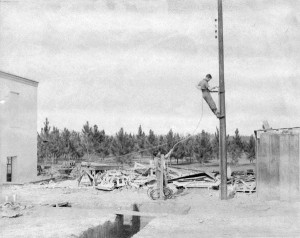One of Extension’s little-known accomplishments is its role in bringing electricity to the rural areas of Florida. In the mid-1930s, only about 12 percent of rural America had access to centralized electricity–in Florida, only 8 percent of farms and ranches were electrified. To get farmlands on the grid, in 1935 the federal government established the Rural Electrification Administration (REA). The REA was a credit agency that extended long-term, self-liquidating loans to state and local governments, nonprofit organizations and farmers’ cooperatives. The loans subsidized utility companies for the extension of power lines beyond urban centers. In 1939, the REA became a division of the U.S. Department of Agriculture, and the USDA handed the responsibility of organizing the farmers’ co-ops to the Extension Service.
In Florida, county agents faced a daunting task. First they had to map out the county, showing where the lines might run and where every potential customer lived. Once the REA tentatively approved the plan (and this often required multiple attempts), agents had to convince farmers to buy into the cooperative, which required a $5 membership fee.
In the early 40s, many of Florida’s farmers were still feeling the effects of the Great Depression. Money was tight and $5 was a lot to ask for a service many thought was just a pipedream—or worse. K.S. McMullen, an extension agent in Leon County, recalled that at least one farmer accused him of pocketing the $5 fee, and took his suspicions to county commissioners, farm organizations and anyone else who would listen.
Once the co-op was established, agents had to work with utility companies to convince them that expanding the grid was in their best interest, and they used REA funds to buy poles and equipment, hire labor and build distribution lines through every forest, field and swamp in the state.

Source: State Archives of Florida. Florida Memory. http://floridamemory.com/items/show/258403
Despite resistance from the government, customers, utilities and the natural elements, 15 co-ops were set up and work was soon underway to bring power and light to Florida’s farms. By 1942 the number of farms with electric service more than tripled, and by the 1960s, about 98% of all farms had electricity and 70% had telephone service.
Today, the electrification of Florida’s heartland is taken for granted and Extension’s pioneering role in it has faded into obscurity. In a way, that makes it the perfect success story.
Sources:
Cooper, J. Francis, ed. Dimensions in History: Recounting Florida Cooperative Extension Service Progress, 1909-76. Gainesville: Alpha Delta Chapter, EPSILON SIGMA PHI, 1976.
Smith, J. Lee. Tracks of Men: A Type of Agricultural Extension History. Unpublished manuscript, 1953.
US Department of Agriculture. A Brief History of the Rural Electric and Telephone Programs. Washington: Government Printing Office, 1982. http://www.rurdev.usda.gov/rd/70th/rea-history.pdf
 0
0
